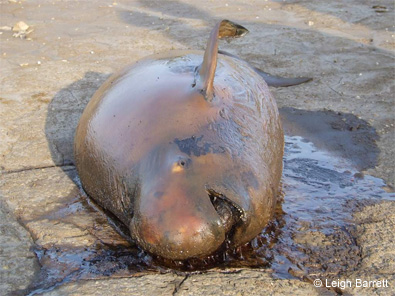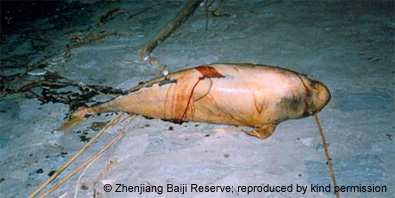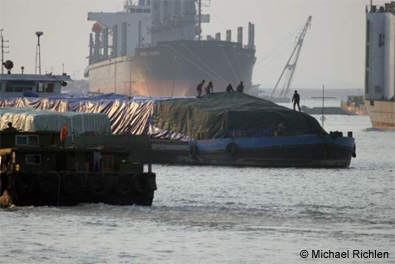Here is the third blog from EDGE’s Dr Sam Turvey about his surveys along the Yangtze River in China, trying to discover the cause behind the disappearance of the baiji, and declines other Yangtze species.
Almost as soon as we had begun interviewing fishermen along the Yangtze, as part of an intensive survey to investigate the possible extinction of the Yangtze River dolphin or baiji, we found out that there was a dead finless porpoise on the river bank near Hukou County harbour at the mouth of Poyang Lake. Detailed study of the dead animal could provide invaluable clues about the factors that had brought about the disappearance of the baiji, and that were driving the continued severe decline of the only population of freshwater porpoises in the world.
It was not a pretty sight. We were told that the porpoise had been lying on the river bank for around 30 days, and it showed. Lathering our noses with VapoRub to mask the stench coming from the dead animal, we set to work on a porpoise post-mortem. Luckily for us, the preceding few weeks had experienced some extremely cold weather – the worst winter in China for fifty years, we were told – and so the porpoise was not extensively decomposed.

The animal was an adult female with a body length of 150 cm. There were no external marks to indicate that it had been hit by a ship or entangled in fishing gear. Looking inside, we found no evidence of broken ribs or lateral haemorrhage indicative of boat collision, or froth in the lungs indicative of drowning through by-catch. The animal had healthy levels of blubber thickness, and its stomach contained several poorly digested fish, showing that it had been eating normally and had been actively hunting for food shortly before it died. So the porpoise had apparently been in good health immediately before its death, which appeared to have been acute and sudden, but there was no obvious evidence of trauma, as would be expected from by-catch in fishing gear or from a boat collision. It is therefore most likely that this animal was killed by electro-fishing.
Electro-fishing is an illegal method of fishing that became widespread across the Yangtze region during the 1990s. It is typically practised by people with little skill at “real” fishing, who operate at night and use storage batteries to fire huge electric charges into the river, collecting whatever dead fish float up to the surface. It is extremely destructive – the lethal electric charge can kill anything within a range of 20 metres, and the charge is left running continuously in the water as the fishing boat drifts along the river. Professional Yangtze fishermen view the electro-fishermen with contempt. However, even though regional fisheries officials told us that they were concentrating their efforts on controlling electro-fishing, they have insufficient support to carry out necessary “sting operations” or survey river sections regularly for electro-fishing. Some undercover operations have been carried out to try to identify electro-fishermen in riverside communities, but these operations have also been very limited.
As we travelled from one riverside fishing community to the next, we gathered more and more data on other dead porpoises that had been seen in the past few years by fishermen and regional fisheries authorities. We are currently analyzing all of the data that were collected during the survey, but it seems that porpoises have been killed by a range of different factors. The two commonest causes of porpoise mortality that could be identified by our informants were boat collisions and by-catch in fishing gear. These two factors are certainly responsible for high levels of porpoise deaths in the Yangtze. As long ago as 1892, a European observer reported that Yangtze fishermen used rolling hook long-lines to snag fish in the water, and “sometimes they have the misfortune to lose the whole line through the hooking of a river porpoise which inhabits the river”. Fishing intensity and associated porpoise deaths have increased as China’s population has grown throughout the twentieth and twenty-first centuries, and the industrialization of the Yangtze region has also led to a massive escalation in heavy ship traffic that deafens porpoises and turns them into road-kill.
However, some causes of porpoise death are more obvious than others. Non-specialist fishermen are more likely to identify porpoise deaths caused by propeller strikes or entanglement in fishing gear, as opposed to less obvious causes of death such as pollution or electrocution, which leave no external marks. Further analysis will investigate if it is possible to tease out the relative effects of these different threat factors from our interview data.
But the porpoise was not the only cetacean in the Yangtze – the main purpose of our survey was to investigate the disappearance of the river’s unique species of dolphin, the baiji. What did the fishermen we spoke to have to tell us about this beautiful, enigmatic, and tragic animal?
TO BE CONTINUED


